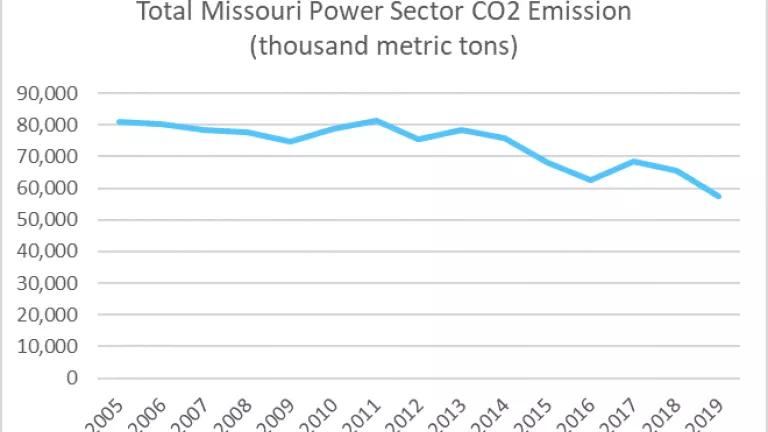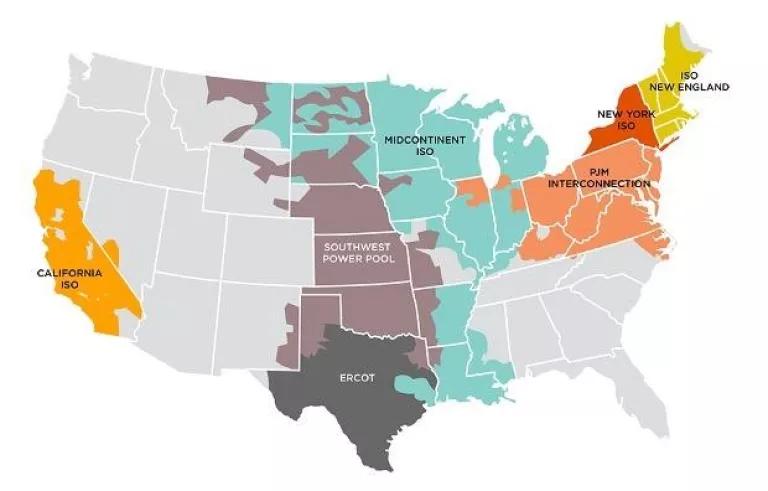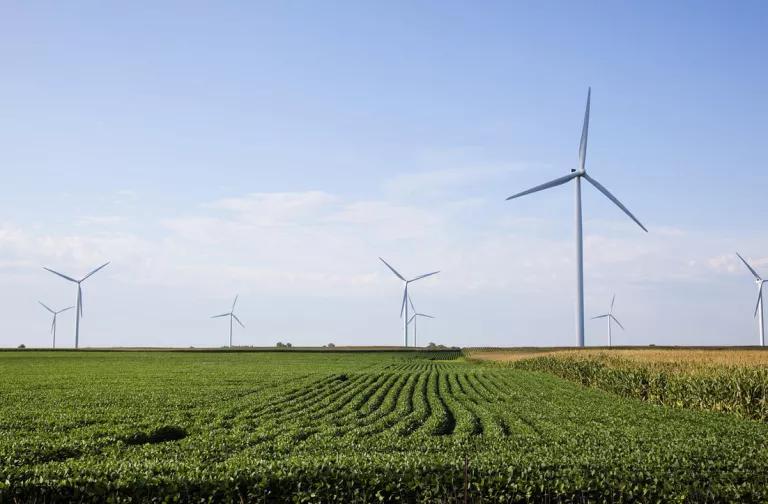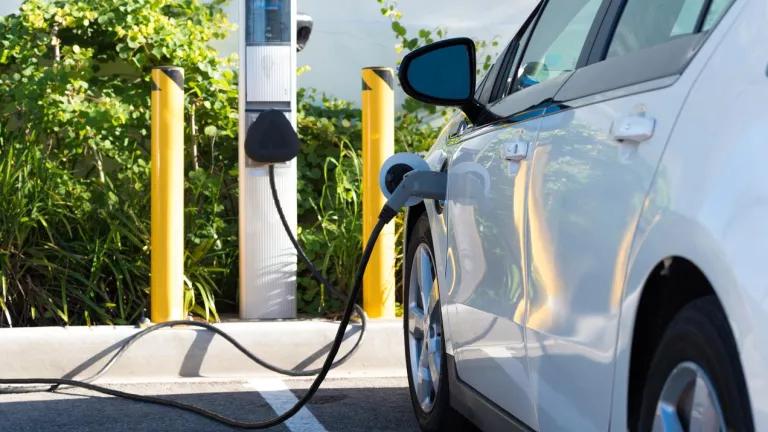Missouri's Path to a Clean Energy Future
Decarbonizing the power sector in Missouri will benefit all electricity consumers and contribute to a healthier and more livable climate. This can be

Missouri has cut carbon emissions from the power sector by 30 percent since 2005—despite being the number two state in the country for coal use in electricity generation. In the coming decade, Missouri must double down to address the climate crisis, grow jobs, and improve the lives of all Missourians.
The to-date progress in emissions reduction is being bolstered by strong commitments from the state’s two largest cities: Kansas City and Saint Louis. Both cities have embraced the goal of zero greenhouse gas emissions by 2050 and are implementing nation-leading decarbonization policies. Such commitments mark a crucial step toward protecting people and planet. The climate crisis is already negatively impacting the health and safety of people all across the state. The solutions to this crisis will not only protect Missourians but are also proving increasingly economically beneficial by creating jobs and cutting energy bills.
The state’s two largest utilities, Ameren and Evergy, have been making strides to cut carbon and clean up their energy generation. Ameren has a net zero carbon emissions by 2050 goal and a commitment to expand their wind and solar portfolio. Evergy aims to achieve net zero carbon emissions even sooner, with a 2045 goal stated in their most recent integrated resource plan or IRP. With the right policy support, both could achieve these already promising targets at least ten years sooner.
Securitization
More renewable energy on the grid benefits consumers by virtue of being a clean and reliable energy source, as well as providing economic benefits to customers. Wind and solar are cheaper to generate than coal, and in most cases, natural gas. As a result, wind generation has grown significantly over the last 15 years, and though solar remains a small portion of Missouri’s energy portfolio, it has been steadily increasing year over year. However, without proper policy support, utility customers could be in danger of paying for renewable development as well as the sunk costs for traditional fossil power assets that are ever-increasingly more expensive.

The good news? Just last month, Missouri - with support from Evergy and Ameren—took a major step toward a clean energy future with the passage of securitization legislation, which Governor Parson signed into law on July 6th. With the passage of securitization legislation, Missouri utilities have a new tool to address the sunk costs associated with uneconomic coal generation—providing an important economic boost to switch from dirty coal power to clean, renewable energy—while lowering costs for electricity consumers.
Securitization is a tool which allows utilities to access low-cost financing so they can accelerate the transition from expensive and dirty coal power to less expensive resources like wind, solar, and storage, while maintaining reliability and reducing energy costs.
When an uneconomical resource, like a coal-fired power plant, comes offline before the plant itself has been fully paid off, that remaining unrecovered cost is still something that utility customers will end up paying for. Securitization shrinks those costs, creating a win-win for the utility and its customers, as consumers would no longer be asked to pay for both uneconomic fossil-power assets and the new, clean energy projects coming online at the same time. With these sunk costs coming off their books, utilities have more room in their budgets to continue to grow their renewable assets, while allowing customers to reap the benefits of low-cost clean energy.
Transmission
While a fantastic tool for cost recovery, securitization alone will not be enough to transition Missouri to 100 percent clean energy. The state will also need to address the transmission and storage of renewable resources. This is necessary to not only reduce carbon emissions but also provide important reliability and affordability benefits.
Transmission refers to the power lines that physically connect energy generation to the end consumer. To best utilize the growing portion of renewable energy generated in Missouri, more regional transmission will be required. Such transmission is key for getting renewable energy resources like wind and solar out of Missouri when there is an excess of supply, earning revenue. On the flip side, transmission also allows us to import low-cost energy into the state when generation is low or extreme weather increases demand. In addition to allowing Missouri to earn income from exporting power, greater transmission can increase the grid’s reliability and lower energy costs for Missouri consumers. That means more, affordable power to the places that need it and fewer outages—even in extreme weather conditions.

Two regional transmission organizations (RTOs), Southwest Power Pool (SPP) and Midcontinent ISO (MISO), are responsible for managing energy flow across much of the Midwest. SPP and MISO are linked to each other with regional transmission lines, however, the current extent of this regional transmission is minimal. With greater connectivity, the economic and energy reliability benefits of transmission could be enhanced. Support for these benefits could come in part from federal action, such as the Bipartisan Infrastructure Framework, which aims to create a Grid Development Authority and invests in transmission to enhance reliability and resilience, while reducing overall costs to consumers and increasing clean energy access.
Storage is an important compliment to transmission, which would enhance reliability. Storage is most beneficial to help balance the load, ensuring energy supply can be shifted to match demand. Luckily, the cost of utility-scale storage is declining fast! From 2015 to 2018, storage costs dropped 70 percent. As the price of this solution continues to decrease, the potential for a cleaner, more reliable grid becomes increasingly cost-effective.

Wind turbines in rural Missouri
The Future
Missouri's path to a clean energy future hinges on decarbonizing the power sector. Decarbonization will benefit all electricity consumers and contribute to a healthier and more livable climate. This transition can be advanced through securitization and coal plant retirements over the next decade, while enhancing renewable energy solutions with wind and solar buildout. We can maximize the benefits of these efforts by supporting complimentary policies and investments, such as the development of reliable transmission and affordable storage.
Such efforts will make it easier to decarbonize buildings, as the clean, renewable energy going into them is carbon free. When our buildings are more energy efficient, they will use less of that clean energy, freeing it up for other uses—like powering our electric cars, buses, and trucks. Each piece of the puzzle fits together to create a single vision: Missouri as a climate leader, with clean air, and a thriving economy.
Missouri is well positioned to grow its economy in an equitable manner with investments that create a cleaner and more reliable grid. Investments such as those proposed in the Build Back Better Agenda, which aims to support states with billions in clean energy investments while bolstering an American clean energy workforce in states like Missouri. The Biden Administration further aims to decarbonize the power sector by 2035 through a clean electricity standard which would incentivize investments renewable resources, storage, and energy efficiency. Such investments will not only help reduce the energy burden faced by many of the people living in Missouri but also support our local economy and make our businesses more competitive. As we move toward a zero emissions future, Missouri is well positioned to be a leader on the new and developing economic opportunities that come with investing in a healthy and livable climate—now we just need to seize them.




